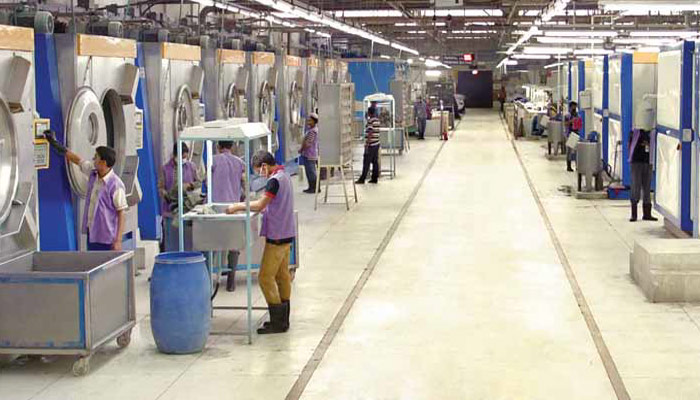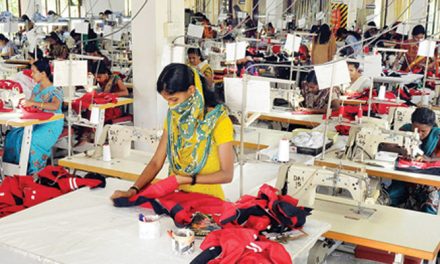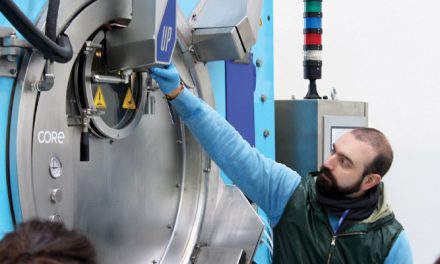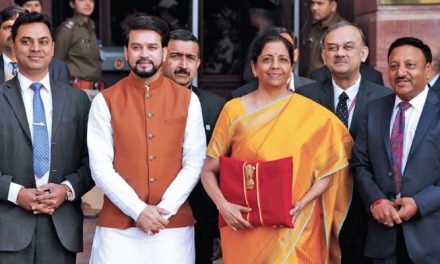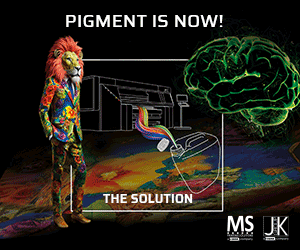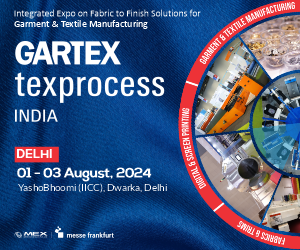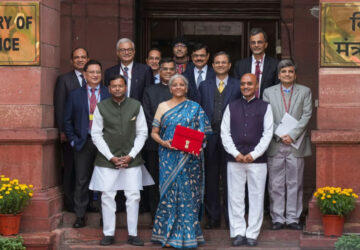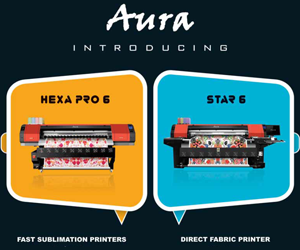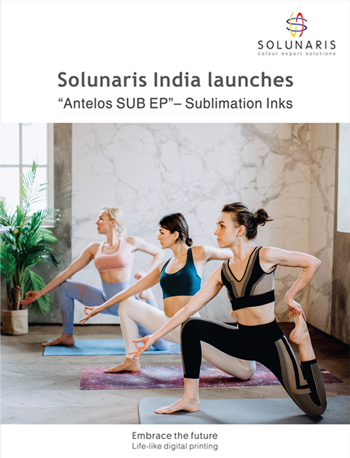The Indian textiles and clothing industry accounts for approximately 4 percent of the global T&C market. The T&A industry is one of the largest and the most important sectors for the Indian economy in terms of output, foreign exchange earnings and employment. The industry contributes approximately 7 percent to industrial output in value terms, 2 percent to the GDP and 15 percent to the country’s export earnings. It also provides direct employment to over 45 mn people and is the second largest provider of employment after agriculture. As per the WTO, India is ranked as 5th largest exporter of RMG in the world.
Indian readymade garments (RMG) industry is the largest segment of the Indian T&C Industry accounting for approximately 50 percent of the total industry. The domestic RMG sector accounts for approximately three-fourths of the total Indian RMG industry. Given that RMG manufacturing units can be viable at all size levels, particularly because of low cost of plant and machinery, the units range from small to large. Consequently, the RMG sector continues to be dominated by unorganised players. However, the branded apparel market has made steady inroads in the past few years. A growing economy, rising disposable income and the growing aspirations of Indian consumers is expected to drive growth in the Indian T&C industry. At the same time, there is growing challenge due to environmental hazards created by the garment wet processing segment of the textile industry worldwide.
In the past decade, there have been NGO movements across different parts of the world- and especially in the producing countries like China, Bangladesh and India – to control these discharges of hazardous chemicals into rivers, lakes and groundwater from textile factories. Governments in China, Bangladesh and India are clamping down on polluting factories and implementing stringent laws for wastewater discharge.
Garment wet processing
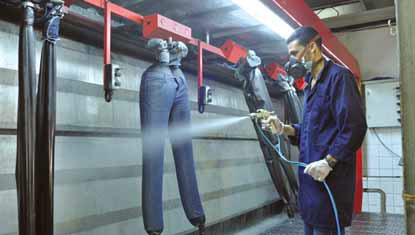 Garment processing provides the garment an identity and exclusive appearance. Different looks, finishing and designs could be made on the apparel. It helps in creating a brand image. Many types of the effects can be given to the garment through the various processes. In comparison to fabric processing it is better, as the wide range of visual effects created through garment processing cannot be achieved at fabric stage.
Garment processing provides the garment an identity and exclusive appearance. Different looks, finishing and designs could be made on the apparel. It helps in creating a brand image. Many types of the effects can be given to the garment through the various processes. In comparison to fabric processing it is better, as the wide range of visual effects created through garment processing cannot be achieved at fabric stage.
Out of four types of textile processing viz.- fibre processing, yarn processing, fabric processing and garment processing, the garment processing has gained momentum in past few years due to denim garments, which is the largest garment segment being processed by this method. There are many advantages of wet processing of denims like it give softness to the garments, eliminates sizing problems, bleaching could be done at preferred parts of the garments, over dyeing could also be done, and so on.
Garment wet processing normally includes pretreatment, dyeing and finishing. Finishing is the final step in the garment manufacturing process and it gives special functionalities to the garment. In addition, the functionalities presented are related not only to the wearer but also to the environmental benefits. Therefore, the basic aspects of functional finishes are applied to highperformance apparel.
The functional finishes are mainly dedicated to chemical finishes (or wet finishing), because this is the one normally used to impart new functionalities to textiles. However, the functionalities are not solely obtained from chemical treatments; instead, it is a combination of chemical, mechanical treatments, and fabric characteristics. For instance, the yarn type and fabric structure are also important. Other possible finishes, include mechanical (dry finishing) and biotechnological finishes. Mechanical finishes are those based on physical means to change the appearance, surface, and dimensional characteristic of the textiles. Biotechnological finishes are mainly those that rely on enzyme treatments for specific surface modifications.
Future trend
The next big thing to expect in the textile industry is the inclusion of technology Just In Time, where after order is placed by a customer on screen via Augmented Reality the garments would be created and trying a sample would be done for the same. This will provide several options to the customer to pick from multiple prints/colours/embroideries/laser effect without the garment being manufactured in the first place thus, saving resources for the unsold apparel.
The fashion industry in the future will be more about the experience instead of appearance. It will be a task for brand owner and key market players as consumers will be more critical about the experience than mere looks. So, there will be a paradigm shift from appearance to fashion with lifestyle solutions.
Shift to circularity
India feels the adverse social and environmental impact of ‘fast fashion’; however, this may change soon. India is a global manufacturing hub for textiles and apparel, coping with growing international and domestic demand. The global textiles market is projected to reach $1.3 tr by 2025. Similarly, the domestic market for apparel is estimated to reach $59.3 bn by 2022. The industry is also critical in terms of income and employment generation, contributing to 5 percent of India’s current GDP. Yet, there is a serious cause for concern. 60 percent of Indian textiles are cotton based, and cotton cultivation consumes 25 percent of the world’s pesticides.
The wet processing of textiles generates an enormous quantity of waste sludge and chemically polluted waters. In addition, textile is the third biggest contributor of dry waste in most Indian States. However, with rising awareness of these challenges, globally and in the Indian context, brands and manufacturers are willing to make a shift to circularity. Hence, forward-looking industry players are preparing themselves for ‘self-disruption’ to build a ‘Circular Fashion Industry’ globally. This would mean building a fashion industry that can phase out substances of concern, increase clothing utilisation, improve recycling and efficiently use resources.
This trend has led to an increasing number of industry-led initiatives such as the Sustainable Apparel Coalition, a group of leading brands, retailers, manufacturers, non-governmental organisations, ZHDC, and government organisations who developed the Higg Index.
Simultaneously for the Indian industry, the local environmental challenges coupled with a globally dispersed value chain embracing circularity, has brought them to the brink of circular innovation. Hence, organisations have started experimenting and innovating towards the circular textile economy goals. This is a strong indication that the textile industry is beginning to embrace the circular economy through serious intent and not just an ephemeral sentiment. The movement is set to remarkably influence and shape the core value system of the industry over the coming years.
Conclusion
In the recent past, Indian textile industry is facing a challenging condition in the field of quality and productivity. Garment wet processing is considered as a big and important factor in garment manufacturing process, with a wide range of procedures, which affect the final product’s appearance, quality and price. Wet processing garments use large quantities of water, chemicals and energy. The highly competitive atmosphere and ecological parameters becoming more stringent, it becomes the prime concern of the processing segment to be conscious about quality and ecology. The guidelines for the textile processing industries by the pollution control boards create concern over the environment-friendliness of the processes, making it essential for innovations and changes in the processes. Hence, the industry is moving towards sustainable processing using less water, chemical and energy and finding alternate ways for processing of garments.
To provide the present industry insightful to our readers, we have asked following questions to different segments of the garment wet processing industry, and their expert comments are covered in next few pages:
• What are the latest trends and developments in garment wet processing?
• Where does the Indian garment wet processing industry lacks? What are the solutions for it?
• What are the new technological developments in wet processing machines?
• What as a garment manufacturer or process house or chemical or technology manufacturer you are doing for sustainable production?
Comments from the industry…

Himanshu Puri
Director,
Himanshu Apparels Pvt Ltd.
The latest trends and developments in garment wet processing are Biological treatment (BT) of waste water and the use of bacteria based dyes and chemicals. The bacteria present in the dyes helps in disintegrating the chemicals during the initial stage of the cleaning process in the effluent treatment plant (ETP). As a result, the treatment of the waste water is carried out more effectively from the beginning itself. After the primary treatment of water in the ETP there are some particles from effluent water that need to be treated biologically to bring down the BOD (Biochemical Oxygen Demand), COD (Chemical Oxygen Demand) and TDS (Total Dissolved Solids) levels in water. The enzymes used during the BT stage help in achieving the same and the water which is finally discharged is within the acceptable parameters. For denim washes factories are using chemicals from companies like CLARIANT and DYSTAR that carry out the de-sizing and enzyme processes together thereby reducing the wash cycles. This also saves water as the garment doesn’t have to go through two separate stages of first de-sizing and then enzyme wash, each requiring fresh water separately, instead the garment goes through only one stage where both processes are done together using the fresh water only once.
The Indian garment wet processing industry lacks in setting up and running of waste water treatment plants. Most firms that have set up Effluent treatment plants (ETP) only carry out the primary treatment process and discharge water, whereas waste water must also go through the Biological treatment (BT) stage before getting discharged. However, the setup and running cost of the plant is high, which is one reason why smaller firms are not keen to invest in it. The government should provide incentives and subsidies to smaller companies and motivate them to set up and run water treatment plants properly. Most garment processing houses use ground water to carry out techniques like Denim enzyme wash on garments. Instead of using ground water, plants can use water from the government sewage treatment plant (STP) thereby reducing depletion of ground water levels in that area. In addition to above companies should perform regular internal audits to check the Ph value and bacteria content of the water that is finally being discharged. These days, the newer models are using nozzles to spray water and chemicals on garments in machines.
Only one tenth of water is used in comparison to the water used by traditional machines. The spray system is not very costly and it also reduces the discharge of chemicals in waste water as lesser chemicals are being sprayed on garments. Some garments go through longer washing cycles where more water is required to carry out the process. For such washes, machine companies have come up with technology where the liquor ratio is substantially less. Instead of using 8 litres of water for 1 kg of material the machines only use 4 litres now. Moreover, we don’t find water dripping on the washing floors now, thanks to the new water extractors that come as a part of the machine itself. Some washing machines also use 35 percent less water in comparison to the conventional machines.
As a responsible garment manufacturer, we always work towards sustainability goals, trying to develop products that are environment friendly. In doing so we are producing biodegradable garments made from sustainable fibres. These garments decompose over time without having to use chemicals that cause pollution thus reducing Carbon Foot Prints. This is a big step towards a more eco-friendly world. We also manufacture and export organic garments certified under GOTS (Global Organic Textile Standard) giving complete traceability to our customers by providing them stage wise organic certification for every order. Having successfully passed the CPI2 assessment, we have been certified a Silver level in energy savings. This assessment is based on how well a company is able to save energy by introducing advanced technology infrastructure that consumes less electricity. In addition to above we only work with processing houses that operate proper ETP plants keeping Zero Discharge of Hazardous Chemicals (ZDHC) in mind.
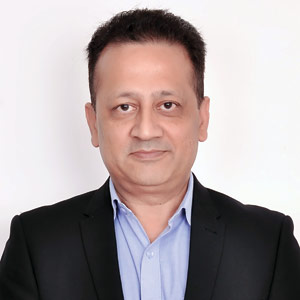
Atul Mittal
Executive Director,
Pratibha Syntex Ltd
With the advancement of the technology and growing awareness of consumers towards health and hygiene, new fabrics are being developed for garments with finishes like intellifresh, new fresh, anti-fungal, UPF protection, anti-stain, anti-odour, anti-static and anti-flame. Recently, a new fabric called kooltex is launched which is developed with specially treated polyester fibre that is responsible for anti-microbial property and provides excellent hand feel. A new concept, brimming over these days, is use of natural Hemp fibre in garments. The natural Hemp fibre has unique properties like UV resistance, air breathability, carbon equalizer and water resistance.
Similarly, for protection from climatic conditions there are some other developments like thermal protection and cool finish. The overall trend is now moving towards sustainable products, which consumes less water and generates lesser waste. The wet processing industry in India is hugely responsible for water pollution. To control the water pollution, there is an entailment of treating water used in processes. But, most of the companies are lacking proper infrastructure and fail to abide by the pollution control norms. And second challenge is availability of skilled manpower.
In my opinion, the solution to these aforesaid mentioned challenges are to infuse state-of-the-art machines in the processes, which consume less water and energy and control environment pollution. It is also important to provide skill training to available manpower. There is an urgent need to make all wet processing industries ZLD and ZDHC compliant to be able to control the water pollution. Strict norms are required on the dyes and chemicals manufacturing companies to stop usage of harmful chemicals.
Today’s necessity is to save environment. With a view to conserve environment, an array of technological advancements has been carried out in wet processing machines which include dyeing, printing, finishing & bleaching. The new technologies have been developed on the context to save water, reduce waste, improve accuracy and reduce manual interventions. One of the latest additions is continuous bleaching & washing. The machines consume minimum water and generate more production with consistent quality. For batch dyeing process, a new technologically advance machine has come up which is called Air Flow machine, which translates into higher production, while consuming considerably low quantity of water.
Continuous tumblers have been developed in the mechanical finish machines to control the shrinkage in light weight natural fabric as well as man-made fabric in high end garments. There are advancements in finishing stenters as well. Online device to control GSM & reading throughout the width & WEKO System for moisture management have been developed on compactor machines. Our company Pratibha Syntex’s tagline is more than responsible textiles. Coming true to what we claim, we have been manufacturing sustainable garments using organic cotton, spundyed fibres, biodegradable fibres, recycled polyester etc. The processes we have incorporated in our dye house are also sustainable in nature. Salt free dyeing (under development), bio scouring, cationization dyeing, fibre dyeing, Cold Pad Dyeing are a few examples of the technologies that we are using in our processes. Besides, we have infused low liquor ratio dyeing machines and continuous dyeing machines (CPB). We are using all chemicals and dyes certified by GOTS or BLUE SIGN. Also using 100 percent recycle water for processing. Our process house is running on ZLD concept.
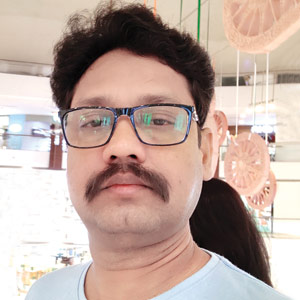
Ravi Shankar Kumar
Manager – Wet Processing,
Neetee Apparel LLP
Textile Industries which is dominated by small and medium enterprises has a wide variety of products with different colours and fabrics. Additionally wet processing consume large amount of water, energy, time and chemicals, which is expensive to separate in the treatment plant. Latest trends and development we archived in last two years are save water by reusing of water and also latest machine which liquor ratio are almost half this process save 50 percent water and 40 percent chemicals. And also half load on effluent plant.
Lack of technical knowledge in wet processing industries is also harmful for the product as well as environment. Need to appoint skill or technical person to handle these chemicals and water saving technology. There are new machine and technology which is developed for save water as well as chemicals. One machine like go green, in conventional technology uses of huge amount of water and chemicals during the process of garment finishing. This machine saves 90 percent of water and 60 percent of chemicals in Softener washing and also in other process like wrinkle free, stain free etc.
The textile industry is part of the industries that continuously harm the environment because of the high water consumption and the presence of various pollutants in the waste water. Waste water treatment is lacking or includes only physical treatment in underdeveloped and developing countries due to installation and operating cost of treatment plant. Sustainable Denim processing as the supply chain needs continue to change both brands and consumers alike and looking for more sustainable options without sacrificing the look and feel that consumers love about their favorite pair of jeans. It is possible to achieve the same designs and overall look of denim while saving waste, energy, time and chemicals throughout the process. Some example like pumice stone should be replaced by using no stone enzyme or machine to save water, energy and time.
Bleach replaced in to Ozone to save water, energy, time and chemicals. Potassium per-magnate, which is used for indigo fading replaced by laser blasting. Manuals sanding also replaced by laser. These all save water, energy time and chemicals. One more change you can do is line dry of garment instead of tumble dry which also saves energy.
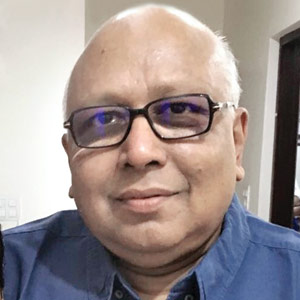
SP Keshan
Director,
Spectrum Washing Pvt. Ltd.
Keeping in mind the environmental impact of garment wet processing, sustainability is the biggest and most important trend in the garment wet processing industry. Sustainability should be ingrained in manufacturing the garment such that the use of water, electricity and chemicals is significantly lower. Sustainable washes can be achieved through a combination of four machines, i.e., a washing machine (With low liqour ratio), a laser machine (to eliminate KMnO4 and relative washing), e-flow machine, and an ozone machine. With the exception of lazor, all concerned machinery is available in India.
One of the biggest challenges faced by the industry is to raise awareness about sustainability amongst manufacturers. There is greater and hyper-awareness among international brands, and we as manufacturers, need to follow suit. Recognized compliances include Sedex, which is a membership organisation for businesses committed to continuous improvement of the ethical performance of their supply chains, ISO 14001 or Green Product.
Meeting all three certificate compliances, we at Spectrum Washing Pvt Ltd achieve sustainable washing, including sulphur and pigment dies in less than 8 litres of water. Comparatively, we conserve 92– 98 percent of water. ECO-WASHED processes are environmentally sustainable washes that finish a garment in just 2-8 litres of water while reducing chemical usage by 75 percent and conserving upto 53 percent energy. In comparison to industry standards of 60-100 litres these savings are staggering. Our latest achievement of sustainable washing processes helps us conserve water, save energy, reduce the use of chemicals and reduce our carbon footprint without having to compromise on the look, feel and the finish of the garment. Our product received positive response during the exhibition at the Bangalore Denim and Jeans show, 2019.
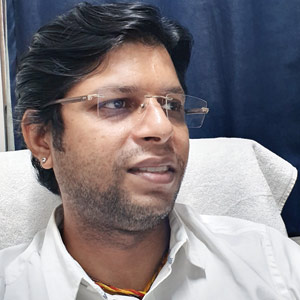
Pramod Jain
Director,
Ajanta Gartex Processors Pvt. Ltd.
Indian garment wet processing industry lacks a few points. Clearcut and uniform policy and its implementation by the government regarding pollution across the country is lacking due to which industries are in a State of dilemma on deciding any further investments regarding pollution control equipment and machineries related to production.
In terms of trends, there is nothing new as such but ways of doing the same processes have changed for better efficiency and sustainability. The new technological developments in wet processing machines include low material to liquor ratio machines are coming these days which helps in reduction of water consumption upto one third in turn reducing chemical and energy consumption as well. Machines are coming for stone washing without the usage of stones. Usage of Conveyor for drying has also picked up the trend reducing the man power and steam cost.
Machines are coming as an attachment to existing front loading machines which can spray the chemicals in the form of Mist (Nano Bubble) which in turn helps in reduction of water and chemical consumption.
As a process house we are taking a lot of initiatives for sustainable production. We are the first factory in Delhi NCR for garment processing who has implemented a complete Zero Liquid Discharge unit with an efficiency of 97 percent recovery of waste water and rest 3 percent gets evaporated. All the machines which we have installed are low liquor ratio machines. For further reduction in usage of water chemicals we have also installed nano bubble machines. Conveyor based drying using natural heat from the atmosphere is also implemented. We are also working on chemicals for certain processes which are biodegradable.
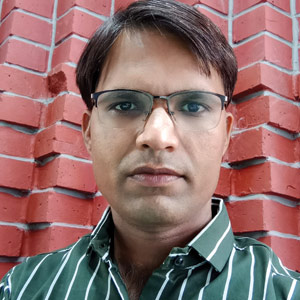
Rajesh Purohit
Owner,
Hi – Life Clothing Co.
Nowadays garment industry of Gujarat is growing rapidly. Gujarat already a hub of textile sector, and it’s also becoming a large quantity and quality manufacturing State in India. In garment processing industry, Ahmedabad have become first choice in quality process in garment and denim industry at all over India, day-by-day. We are (Hi Life) leading processors since last 15 years in Ahmedabad. We are members of GGMA and ATPA. In Ahmedabad processors are expanding their production and adopting automation in their units. They are strictly following pollution norms of pollution boards, and day-by-day because of shortage of ground level water they are trying to reduce their water consumption with new technologies usage. Further every processor must have to be ready for usage of recycled water. For all these, they need proper land and infrastructure for smoothly running their business.
So, government should provide them these at reasonable price or facility to pay in installments. It should also provide a separate area especially for garment processing industry in any nearby city. There are so many new technologies and automatic machinery for quality process in garment industry available nowadays. But these are very costly and unaffordable for small scale processors. So, government should provide loans for these machineries at zero percent interest rate.
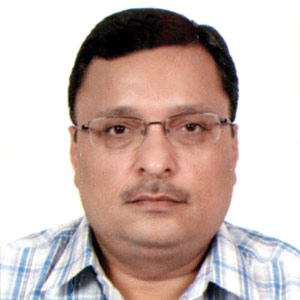
Alok More
Director,
Mayur Processors Pvt. Ltd.
The latest trends and developments in garment wet processing is different types of value added wash. Indian garment wet processing industry is lacking for new technology as all the latest machine manufacturer are from Italy, Spain and Turkey, and the machineries are very costly. Indian market needs cheaper product and the foreign buyers come to India to buy cheaper products apart from other countries. Textile Ministry should take initiative to develop this industry by helping subsidy, finance and technological up gradation. Besides, I would like to request Government of India to take initiative to develop this garment wet processing industry as a new textile processing sector.
As a process house we have taken certain initiatives for sustainable production. We have 2 process houses for garment wet processing. If a person put a process house for garment wet processing firstly he should put 1 ETP Plant to run the factory and the ETP Plant cost is around 50 percent of the production unit and there is no subsidy on ETP from Central Government or State Government. Nowadays, people are fashion conscious and this industry is growing as this makes garments more fashionable. For example jeans – If you have not processed jeans then nobody can wear this. Nowadays, there are some new technological developments in garments wet processing, such as laser machines, ozone treatment, softness finishing by spraying system etc.
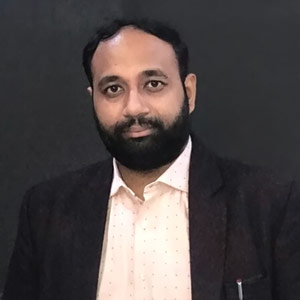
Pranay Goyal
Director,
Washerman
Sustainable garment wet processing is one of the latest trend and is a need of an hour. When I mention sustainability I mean various techniques we can adapt to considerably reducing down our energy or natural resources consumptions. In the next quarter we are in the process of shifting our electricity consumption to Solar power for generating our own electricity. There’s also our development transformation and continuous effort for transforming our Steam consumption for boiling to solar glass tubes boiling. This sustainable process will not only reduce down our electricity usage but PNG consumption too.
Our Indian garment wet processing industry lacks in terms of inappropriate government policy changes. It’s an unorganised sector where support of our government is least. It’s only an Indian entrepreneurial will, facing hardships on everyday basis and high production cost. Solutions are stable policies irrespective of governmental changes.
When it comes to new technological developments in wet processing machines, nowadays few Indian companies are doing very well in bringing about sustainable solutions for reducing down water usage to 90 percent with their 3 in 1 developments making process qualitative yet reducing down energy and manpower usage considerably.
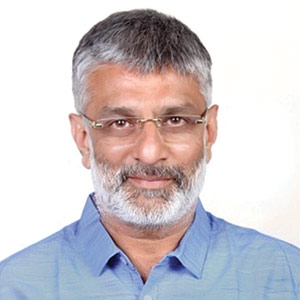
Ajay Ghariwala
Technical Head,
Shreeji Prints Pvt. Ltd.
Our unit Shreeji Prints Pvt. Ltd. is located in Pandesara, Surat. It is well equipped with all modern machinery, having textile processing production capacity of 2.5 lacs mtr./ day. We do processing of 100 percent polyester, cotton, viscose and its blends. We also have facility of direct disperse and sublimation digital printing fabric. We have recently added Direct disperse digital printing machines, Sublimation transfer printing machines, Modern Rotary and Flatbed printing machines and Rotary engraving machine for better accuracy in print quality. In future we plan to achieve sustainable growth and total customer confidence with atmost care of environment and ecology. We also plan to do fabric wet processing and garment manufacturing under one roof.
Environmental hazards of the garment wet processing have been a major concern for the industry. A a company we are doing taking various initiatives for sustainable production like minimum usages of water, energy and chemicals; Use of biodegradable product for fabric processing; Re-circulation or reuse of water and energy; Proper treatment of effluent waste water; Use of ecofriendly products – APEO / NPEO Free, OEKO TEX Compliance product; Check MSDS and TDS before using the raw materials of dyes and chemicals.
The latest trends in garment wet processing and finishing nowadays are digitally printed fabric and garment; Wider width fabric for conceptual garment preparation; Requirement of re cycled fabric. There are certain areas Indian garment wet processing industry lacks like Old aged technology for processing consumes lot of water, energy and chemicals; and insufficient knowledge at application level about usages of technology. So, to overcome the same it should use modern machinery and techniques for sustainable growth. Also, technical knowledge upgradation at operation level in wet processing should be promoted.

Abhishek Kamble
Technical Manager – Textile,
Ecocert India Pvt. Ltd.
Ecocert is a global leader in certification of organic farming, cosmetics and textiles. We take human safety and environmental protection as a top priority. We understand the damage to humans and nature that occurs when responsible practices are not adopted. The biggest environmental hazard for garment wet processing is chemical discharge through waste, water and air. Harmful expulsion from chemical units does not only impacts (sans s) local flora and fauna but disturbs local ecosystems as well. A recent case to highlight is one where dogs in Mumbai’s Taloja area were turning blue because of discharge emitted by the factories.
During our audits of wet processing units under the GOTS standard, which is widely accepted for organic textiles, we take several measures to control environmental hazards. Amongst them are: validating the chemicals used, checking the installation and use of ETP, sludge disposal procedure, water discharge procedure, boiler passing certificate, and consent certificate from government for air and water. Certification process ensures only approved chemicals are used, thus minimizing the impact on the environment.
Overall, there is increasing awareness about the impact of wet processing on the environment, so businesses are looking at ways to minimize the impact of production and processing. Organic and recycled textiles are picking up quickly in the market. In India, there are about 1,000 factories that are certified organic. It is promising to see leading brands launching organic product lines. The advantage with recycled fabrics is that they use less water. Recently, we have also seen garments manufactured from recycled PET bottles. Overall, we can say the future belongs to sustainable businesses.
Although the Indian textile market is huge, the majority of our manufacturing units rely on exports. There is huge potential in domestic retail markets as well. The domestic market in India is expected to grow to about $250 by 2019. In an environmental context, lack of awareness about the sustainable manufacturing processes is a major challenge facing India. Such lack of awareness and sometimes commitment from businesses leads to non-adherence to government regulations, causing problems to the environment.
Spreading awareness about sustainable practices is one thing that can guide us to a safer future. We strongly encourage businesses to follow sustainable and eco-friendly practices and follow rules like having ETP and follow COD, BOD, limit pH value etc. At Ecocert, we can help professionals from the textile industry to improve their processes in order to build a more sustainable world by providing expert consultancy to develop and adhere to sustainable practices that include technical and social aspects.
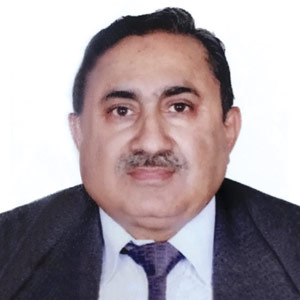
Sunil Sehgal
Director, Anupam Tex Processors Pvt. Ltd.
Garment wet processing industry is passing through a very difficult phase with lot of pressing demands for sustainable dyeing and washing process requirements. This includes induction of new machines with low water consumption technology along with use of dyes with high exhaustion rates.
We are upgrading ourselves with new technology machines and also using new technology for dyeing where use of common salt and soda ash is completely eliminated thus reducing the pollution in a big way. Use of natural vegetable based dyes which are eco-friendly is also being carried out.

Dhirendra Singh Gautam
Director Marketing Dyes,
Huntsman Textile Effects
The textile wet processing sector remains massively dependent on water. Using conventional dyeing equipment and processes, it takes an average of 30-40 litres of water to dye 1 kilogram of knitted cotton (excluding pre-treatment and finishing), and up to 100 litres if older and less efficient dyeing technologies are used. This is a challenge in India, where water scarcity is a serious issue and the government aims to cut industrial water use by 50 percent in the next five years. As a major supplier of textile dyes and chemicals for the textile and apparel industry in India and around the world, Huntsman Textile Effects invests heavily to find costeffective solutions to the industry’s water dilemma. Our breakthrough AVITERA® SE range of poly-reactive dyes reduces the water required for cotton dyeing to 15-20 litres/kilogram, delivering water savings of up to 50 percent compared to previous bestavailable dyeing processes.
The AVITERA® SE wash-off process also requires a lower temperature of about 60°C instead of closer to 100°C for conventional washing-off. This slashes energy consumption by up to 50 percent and makes washing-off up to 25 percent faster. Due to the efficient process, the productivity gain is 25 percent or more, which provides better return on investment for mills. This is a critical time for the textile value chain in India. Our customers are feeling the impact of shifting fibre trends, changing consumer preferences, higher operating costs and the pressure to meet stricter environmental standards. While cotton dominates production in India, global demand for polyestercellulose (PES/CEL) blends for sports and athleisure apparel and home textiles is growing at a faster pace. The challenge for mills diversifying into PES/CEL dyeing is that two separate dyeing processes are required, adding production time and cost. Huntsman Textile Effects’ answer is a combination of our AVITERA® SE reactive dye and TERASIL® W/WW alkaline-clearable disperse dye. Compared to conventional exhaust PES/CEL dyeing, the Huntsman dyes reduce the dyeing process time by more than 40 percent and eliminate the need for intermediate reduction clearing. This also reduces water and energy use by around 50 percent. This sustainable solution also provides excellent washfastness and outstanding reproducibility for improved mill productivity.
Alongside this, there is a clear trend towards textiles with more functionality – again for the sportswear, athleisure and outdoor segments. Our priority is to help customers in India innovate to deliver higher-value eco-friendly products that improve their competitiveness and penetrate new markets. For example, new nonfluorinated durable water repellents under High IQ® Repel meet the need for extreme rain- and stain-protection, while High IQ® Sun Protect gives fabrics long-lasting sun protection that complies with global standards for safety and sustainability. Huntsman Textile Effects helps mills avoid capital investment while making productivity gains. Our AVITERA® dyes deliver dramatic water and energy savings and shorter production times when used with conventional dyeing equipment.
We also work with mills through our longstanding Productivity Improvement Program (PIP). Under this program, we bring our research and technology innovations to a specific mill or plant with a customized solution that delivers results without capital investment. A typical mill will achieve energy and water savings of around 20 percent or 25 percent as a result of a PIP with Huntsman Textile Effects, allowing for cost savings and environmental benefits. At Huntsman, we are committed to bringing the latest technologies, sustainability solutions and marketleading products to our partner mills and customers. We take a collaborative approach to provide customized and innovative solutions to solve their market challenges. This includes the transition to the use of sustainable products, such as AVITERA dyes which help mills and customers improve their yield, productivity and sustainability footprint.
We are also accelerating the industry drive for sustainable production as a ZDHC Contributor, by sharing our detailed safety and sustainability information of our key products onto the ZDHC Gateway Chemical Module. This will support brands and mills in selecting products and practices to make their supply chains more sustainable.
In the area of zero liquid discharge (ZLD), the Indian government’s ZLD guidelines for textile plants and certain textile clusters have raised interest in ZLD technology across the nation. Huntsman Textile Effects is now in the process of deploying a ZLD wastewater management system at our Mahachai dye manufacturing plant in Thailand. In this system, wastewater with a high level of total dissolved solids (TDS) is concentrated and then evaporated into recyclable crystalline salt. Wastewater with low TDS is recycled and reused for manufacturing on site. This ultimately improves our environmental performance, with no liquid waste discharged from the site. This project may also be extended to our other sites, such as India and Mexico as a further expansion of our sustainability efforts.
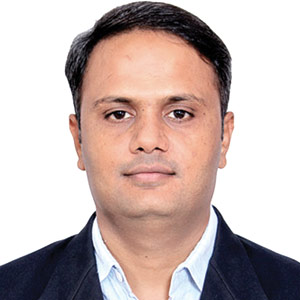
Parthiv Panchal
Director,
Onyx Machinery Pvt. Ltd.
There are three major steps in order to achieve sustainable which we all know. Reduce / Reuse / Recycle for wet processing industry. Reduce: In last decade there has been revolutionary change in garment wet processing for reduction in use of water & energy, start from changing of traditional belly washer to front loading washing machine for low liquor ratio and from front loading to Jet spray mechanism or other mechanism to reduce further liquor ratio into wet processing, Now latest trend is Nano Technology which reduce water consumption by 80-90 percent compared to Front loading Washing machine in certain process.
Apart from this there is laser technology which has been upgraded for higher production, Ozone Technology & also sustainable drying system. Latest trend in garment wet processing is combined all these technology while producing garment to save water & energy which will make all us more sustainable. Recycle: For Recycle process also there has been revolutionary change or development, which have been done like waste water treatment process. Compared to traditional Biological treatment there are technology like Electro Coagulation Technology, CDRO Technology, MVR Technology, according to us these technology should be promoted more in order to avoid any human error to ensure proper result.
Reuse: Reuse of water, reuse of energy to conserve more what we have. Indian garment wet processing industry does not lack technology but lacks self-awareness and knowledge to adopt new technology or process. All major brands have taken steps towards it & all major manufacturers have also started adopting such technology but that is only 30 percent of market share in India, balance 70 percent domestic market producer needs to be aware about the situation and adopt such technology which save water & energy.
As far as new technological developments in wet processing machines is concerned, they have been upgraded to get better and higher production. Like laser technology has been upgraded to achieve higher production, also can avoid few water process like PP neutralizing etc. by using HDR technology, Ozone Technology has been upgraded to achieve result up to bleach level in less time, Nano technology machine along with revolution in chemical technology has been able to achieve more result with very less water. Sustainable drying system has been developed to save steam energy. We as a Technology / Solution Provider have developed such technologies like ECO-N Machine (Nano Particle Technology Machine), Ozone Technology, Sustainable Drying Technology & also done tie up for laser technology with European Brand.
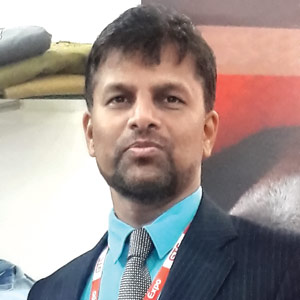
Jayesh Rao
GM Sales – Marketing,
Atlantic Care Chemicals
Sustainability & Spirituality are the global affairs these days. Both have to work in tandem. As first tries to keep entire universe to cosmos to the world in harmony a “Perfect Eco System,” totally synchronized with each other & Second makes an individual a most sorted human being thoroughly sink in with chronicles of life. Until both have joined hands success is far distant objective. In real sense success is when your surrounding is happy. Sustainability is not a concept, it is a routine, a part of life, it is how we conduct our day to day working to create space & scope for better future. When we see textile / garment wet processing consuming irrevocable part of Earth i.e. water massively, our heart goes out & eyes filled with concern. So it would be imperative to work towards a wet processing utilizing no water else atleast less water. We at Atlantic Care offer process to enhance performance & save water.
One bath Desizing & Enzyme is aged old technique to saved water but no one could really fit the combination of Clay based Desizing (Oxy / L-70) & Hetero-functional immoveable Enzyme (E888 – pwd/ liq.) to set the path right. Also on the top current Lycra based Knitted Denim shows crease mark, it can be averted conveniently. Some of the latest products are:
Firstly, Novosize OXY / Novo D Boost L -70 and Organic One shot desize combi – Powder. Its benefits and application are one shot organic desizing formula which performs better than combination of chemicals in the enzymatic de-sizing process and one shot formula which eliminates dye suspenders, modified amylase, lubrication agents, anti-back staining agents etc.
Second Product is Novowash E888 L / Neutral Liquid Bio- Polishing. Its benefits – applications are one bath application saves water, energy, time & cost and have stone wash look to replace Pumice Stone to the extent of 70 to 80 percent. Ozone Treatment: Canadian Government reports exposure to ozone at 0.1 ppm cause irritation to the eyes, nose & throat, at 50 ppm death can be expected. For Bleaching a denim 5000 to 7000 ppm are used this is really deadly. Third Product is Novo lite ULTRA and its benefits – applications include that it is substitute for Ozone by most innocuous product with single rinse and this saved substantial amount of time, energy & give healthy working atmosphere to the people around.
Lashing on to the washing fraternity is as obsessive as we missed out real chain of entire operation. Cycles ends at washing but starts some ones mindful creativity. Much more attention is needed to create hard core sustainable fashion which comes through real love & care. An individual who is miles ahead of the crowd that latches onto trends in vogue, where it is convenient to fall prey to the fetters of fast fashion. Such individuals prefer a change in path where science meets fashion & style meets sustainability. The UPCYCLE movement is very different from recycling – the latter refers to repurposing a product by breaking it down.
UPCYCLING is fairly new in Indiainternationally few brands found possibilities in discarded fabrics, they source damage saris from India & BD, sterilised & work on them. Many designers among the growing tribe of Indian designer who have turned to upcycling to create new & better value from production waste. Another talk of the town is VEGAN Clothing, A vegan products is non-animal based product & even not tested on animals. It is believed that vegan products are ecologically more sustainable than their animal based counterpart. More over fabrics are gentler, cleaner & overall more hygienic.
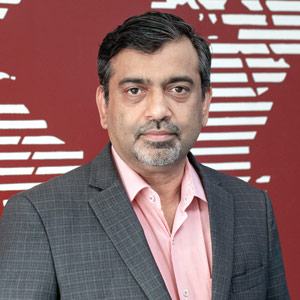
Ganesh Srinivasan
CEO,
Resil Chemicals Private Limited
Presently, water saving is a major area of concern in the garment industry. Most of the units located inside the major cities are moving away to distant locations due to poor availability of water and to meet pollution control norms. The garment washing industries are shifting to low liquor processing machines especially spray machines for finishing of garments. The chemical consumption is also drastically reduced using this type of process.
Today, scale is a major challenge for the Indian wet processing industry. The number of machines per washing unit is less compared with similar set up in Bangladesh or Vietnam. This makes the Indian industry less competitive in the global market.
As a speciality chemical manufacturer we are developing chemistries suitable for spraying process and chemicals that are stable to low liquor processing methods. This will help industry to save energy and water hence we contribute to sustainability. Besides, washing with less water and spray systems are the new technological development in the industry. This also reduces drying time and energy saving during drying process.
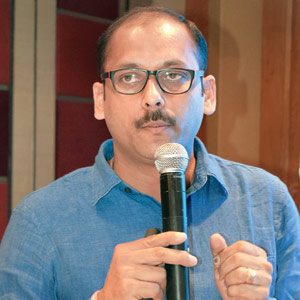
Manuj Kanchan
GM South Asia,
Jeanologia
Water is the new word in denim wet processing. Finally, the importance of water is felt to denim industry and this is a very good sign. Today to make a fashion garment using less amount of water is surely a possibility and Jeanologia has many good ways to achieve dehydrated jeans. The Indian garment industry lack in R&D in a big way, we have been a follower from the beginning. We feel these needs to be changed as our country has the best of brains. Another thing that our industry faces is slow decision making and too much of analysis.
When it comes to latest development in the industry, the new thing is operational model rather than any new technologies. The individual use of all technologies is very clear and customers are aware as well. The success lies in weaving all these together to achieve right 3 Ps – product, position and profit.
Fortunately Jeanologia knows only one way and we know this is the right way. We are committed to bring transformation in denim Industry by making Jeans 5.0. The fashion product that is without manual hand sanding, no stones, no PP spray, zero water discharge and no substance of concern. I am sure Jeans 5.0 will the right product for the industry.
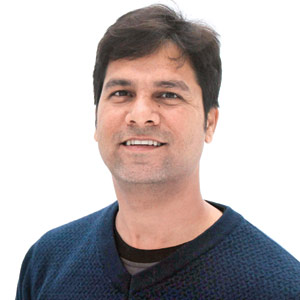
Sanjay Katode
Assistant Manager (Business Development Laundry),
Dystar India Pvt. Ltd
Garment wet processing is driven by domestic and international brands. Due to water pollution created by this industry many small scale and unorganised units are either closing down or adopting new technologies. With global water crisis and pollution issues latest trend is to move from traditional washing approach to sustainable washing approach with no compromise on aesthetics, comfort and functional properties. As a sustainability leader, DyStar developed a range of auxiliaries for optimization of chemical and water usage in laundry industry. Cadira® Laundry Product Range – From pretreatment till finishing, DyStar/Kaiser has technical knowhow and products which are in sync with sustainability. Cadira® Laundry product range is designed to save highest amount of water and energy by ecological processing of denim and non-denim garments. Further our products are certified by global compliance bodies such as ZDHC, REACH, Bluesign®, APEO Free, Cradle-2-Cradle, GOTS, SAC, Oekotex®, Screen chemistry. Overall, Indian garment wet processing industry lacks in various areas such as inadequate infrastructure, unorganised garment wet processing sector, with not enough capital to upgrade technologies, operational ETP and ZLD systems. Moreover, the quality dyes and auxiliaries used are not in sync with compliance requirements coupled with uneducated work-force. As a market leader, DyStar/Kaiser global laundry team is conducting systematic training programs for textile and fashion institutes, brands and garment washing units to create awareness and move in sustainable direction. They also develops exclusive collection for their partners which is based on global trend and market demand.
As far as new technological developments in wet processing machines is concerned, garment wet processing material to liquor ratio is shifting from 1:10 to 1:1 and in some cases as low as 1:0.6 with latest products, process modification and machineries. Laser, Nano Bubble, Ozone and Jet spray technologies are the latest developments in machines. Cadira® Laundry product range is ultimate range which is well-matched with available newer technologies. For laser technology DyStar has designed two innovative & ecological laser solutions. Lava® Con LSB – Get ready for the fastest & easiest way of achieving the most natural sand blasting look. No further processing step necessary.
Lava® Con LAC – Enhance laser power to save energy and increase production rate. The use of a laser activator is much safer, especially for fabric containing elastane, polyester or other synthetic fibres. Sustainable PP replacement System – DyStar/Kaiser with VAV technology developed very first, local enzymatic bleaching system w/VAV Da Vinci 0B48. Lava® Zyme NBF is an innovation by DyStar developed for the local bleaching application which avoids use of hypochlorite or potassium permanganate (PP).
At Dystar Group, Sustainability is our commitment. We are trusted providers of Colorants, Auxiliaries and sustainability services. We place sustainability into the core of our business which has positive impact through entire supply chain. We are the most preferred partner for key industry players to improve current processes by implementing latest technologies and ecological chemistry. We give seminars on sustainable practices all around the world to connect bridges between our partners and to contribute towards the environment.

Thomas Aplas
Manager Technical Service Garment,
CHT Germany GmbH
As a responsible chemical company, the CHT Group developed a range of ecologically and economically intelligent innovations based on organic acids that abandon heavy metals and chlorine: organIQ.
In conventional treatment, KMnO4 is sprayed on the textile to create a ‘used spot’ by local bleaching. However, as a CMR substance, it is very problematic from work safety and ecological points of view. Due of that CHT developed organIQ in order to replace KMnO4. In the process, KMnO4 transforms into manganese dioxide, which has to be neutralised and removed by adding further chemicals that pollute the waste water. The KMnO4 treatment is usually followed by a stonewash in which a lot of stone abrasion, i.e. sand, gets into the waste water and combines with fibre fluff, detached indigo, etc. to form a kind of sludge. After the stonewash process, the jeans are often brightened with chlorine bleach. This bleaching process also has to be neutralised, which means that additional chemicals that pollute the waste water have to be added.
At the same time, it enables enormous cost savings on water and energy. organIQ BLEACH, unlike KMnO4, does not require expensive neutralisation, but can simply be rinsed out. In addition, it is biodegradable and does not pollute the waste water with toxic substances. This drastically reduces waste water treatment costs. Additionally, we were able to make the organIQ system suitable for extremely water-saving application techniques via fogging systems. Now, we can offer an ecological, financially feasible alternative to KMnO4, chlorine bleaching lye and pumice stones.
The close cooperation with leading machine manufacturers in the garment sector was crucial for making this new, highly ecological system as efficient as possible. Our expertise was key to improving existing fogging technology, so it could be applied on a broader scale. As a result, denim laundries all over the world are increasingly equipped with fogging systems on their washing machines, which contributes to a significant reduction in water consumption and also brings the use of chemical additives into a more controlled and therefore more responsible framework. Besides, we are always looking for the latest garment trends in the field of dyes and auxiliaries for our customers to offer them optimal solutions for their individual requirements. For this reason we regularly publish a trend report with the most important developments on the garment sector.
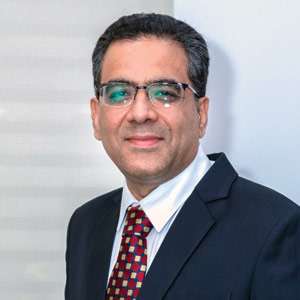
Puneet Arora
CEO,
Rossari Biotech Ltd.
Globally, the garment wet processing is evolving rapidly, emerging technologies are focusing on sustainability aspects like – curbing carbon footprint through thermo-mechanical usage reduction and innovative methods of applications for curtailing water consumption by adopting ultra-lowliquor, spray/mist, waterless dyeing, digital printing techniques. The productivity enhancement is aimed through combining two or more processing steps, efficient use of biocatalysts and increasing the level of automation wherever possible to meet new industrial revolution in Textiles 4.0.
The Indian garment wet processing industry lacks at certain points. Comparatively, our domestic market is still largely dependent on manpower-intensive, long liquor ratio/ water-consuming and less energy- efficient wet processing machines and methods. This is not only affecting our quality/consistency in terms of the end-use expectations but also restricting our ability to cater to the large volume, low-cost export markets. Understanding and realising the evolving market dynamics, our garment wet processors should quickly adapt to the market needs & adopt ways to meet it. World over, many research and technology-based machinery manufacturers are continuously developing and upgrading mechanical systems to simplify wet processing, improve quality, enhance productivity and reduce environmental impact. Recently, a large number of innovative machines and technologies were showcased by many industry stalwarts and start-up entrepreneurs at ITMA, Spain.
Our company Rossari Biotech Ltd, as the largest textile auxiliary chemical manufacturer in India, and pioneer in promoting Green chemicals, are committed to continuous product innovation through a team of dedicated specialist research scientists, automation and expansion of manufacturing plant to ensure consistent quality and timely supply to the garment wet processors. Maintaining pace with the developments in the latest trends in machinery manufacturing technologies, we have developed products based on Bio-catalysts for water and energy saving applications and speciality effect finishes for imparting desired end-use performance properties.

Kimberly Nelson
President,
Garmon- Kemin Industries, South Asia Pvt. Ltd
For the past few years we have heard the word sustainability tossed around more and more. It seems that it is no longer such a trend, and instead it is an idea to stay. However, introducing the idea of sustainability has previously been showcased only for basic washes, never including the high fashion trends that so many brands require. We completely support these important efforts, and work with our customers and brands daily to help translate their fashion trends into sustainable washes. Whether it’s the latest trends in acid washes, galaxy effects or salt and pepper looks, Garmon is constantly evaluating new chemistry, new processes and new application techniques to better our customers’ trend offerings to their brands.
The Indian garment industry is still very fragmented in terms of piecing together the complex sustainability platform so many export and domestic brands now demand. Total solutions including machines, processes and chemicals that all qualify as sustainable are few and far between. Many wet processing manufacturers rely on one, or at best two, of these technologies. Last year, Garmon introduced the greenofchange® platform for this very reason – to help all laundries and processing facilities better understand how their processes, chemicals and machinery better give a wholistic sustainable approach.
As a chemical manufacturer, Garmon Chemicals (part of the Kemin group) has been pioneers in the industry for over 30 years, continuously providing sustainable solutions for all laundry needs. We have patented technology backing our research, resulting in over 150 products listed in the ZDHC Chemical Gateway. Garmon has also started hosting greenofchange® days all over the world, in the hopes to educate various members along the garment supply chain of sustainable practices. Bringing together brands, laundries, mills and outside industry personnel (Like government officials from environmental departments), we create valuable conversations and bring together insights on how we can all commit to a sustainable future.
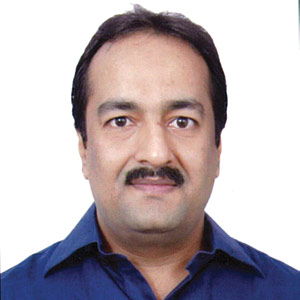
Ajay Sanghavi
Innovation & Technical Service Manager,
Novozymes South Asia Pvt. Ltd.
In step with globalization, consumers around the world are growing accustomed to quickly getting what they are craving. And in a fast-paced industry where fashion is constantly changing, there is no time to waste. As a consequence, laundries have to act fast when new trends arise and demands roll in from retailers or brands – and they are expected to behave as socially responsible citizens while doing so. Sustainability is an issue on the radar of companies and governments around the globe. As a result of this – and of being a very water- and energyintensive industry – pressure is being put on the textile industry by politicians, NGOs, and public opinion. But the efforts and demands to be sustainable are very inconsistent on a global scale, and each country has its own stance or opinion.
At Novozymes, we are unique in our dedication to enzymes and microbes. For more than 70 years, our work with these biological problem solvers has made a big difference to our shared world. Our purpose is “Together we find biological answers for better lives in a growing world.” We are committed to help solving three global challenges: Climate, water and sustainable production & consumption. Beautiful biology of Enzymes and micro organisms that we find in nature make textile products more sustainable. Nature’s enzymes and microbes are at work everywhere – from converting sugar into energy inside your cells, to enabling photosynthesis in the trees and plants outside your window. They may be small, but they make a big difference. With our customers, we turn to biology to unlock business opportunities across industries, higher production output, raw material, water and energy savings, new, differentiating products, cleaner, smarter, safer production and sustainable growth today consumer perceptions are changing as per Euromonitor- 61 percent of consumers are worried about climate change and 65 percent of consumers try to make a positive impact on the environment through everyday actions. The first thing a consumer or brand can do according to the Ellen Macarthur Foundation, the most direct way to reduce waste and pollution in textile manufacturing is simple: Increase the average number of times that clothes are worn. Many customers value highquality, longer-lasting clothes, but they lack the necessary information to take action. Novozymes Livelong® is designed to communicate powerfully with people who want longer-lasting, more sustainable by extending life of textile by 20 percent.
Efficient, safer, more environmentally-friendly textile processing with enzymes are opening up new opportunities in sustainable textile manufacturing. Enzymes let textile mills and laundries save energy, time and money. Consumers and brands get the high-quality, sustainable fabrics that are swiftly rising in popularity. New opportunities arise in denim abrasion and finishing with the right machines and enzymes. Laundries can differentiate their products to brands. And brands can make new sustainability claims to consumers. Save 90 percent water in denim abrasion and finishing with our latest innovation of DeniSafe® concept. Making one pair of stonewashed jeans requires a lot of water, chemicals and energy. But with the help of enzymes, stonewashed jeans can be produced more sustainably without the use of stones. Novozymes DeniSafe® is a certification system for spray machines and enzymes. This enables safe use of enzymes in new low-water washing machines using mist technology. Contact us to get in touch with the certified machine manufacturers. DeniSafe® system lets garment laundries reduce water and energy by up to 90 percent and saves costs on chemicals. The low water levels boost the effect of enzymes, making complete pumice stone replacement a reality. DeniSafe® is just one of the many solutions that Novozymes offers.

Flavio Tonello
CEO,
Tonello Srl
A lean production model involving only two technologies that centrally manages the entire finishing cycle both efficiently and flexibly, reducing waste and optimizing resources. First, Laser Blaze replaces manual abrasion processes allowing the creation of authentic vintage effects. Our All-in-One-System performs all washing operations by integrating 4 sustainable technologies into a single machine: ECOfree 2, NoStone, UP and Core. Finally, we use Metro, completely new, innovative, and user-friendly software for measuring consumption and operating the entire laundry, optimizing the processes and ensuring unparalleled performance and flexibility. All of this is what we call The Laundry (R)evolution: The sophisticated fruit of a radically new conception in garment finishing processes.
To remain competitive, the Indian garment wet processing industry has to invest a lot in new sustainable technologies; this is the only way to keep them updated in a market changing quickly. I’m talking about sustainable technologies, because are the only ones that, in addition to the huge added-value in terms of the environment, can grant the manufacturers a fast return on investment. Our latest technological developments are Wake and OBleach. These are patent-pending processes that we’ve launched at the recent Kingpins in Amsterdam. Wake is the first totally natural dyeing system. In fact, it uses only plants, and vegetable waste, items such as flowers, berries, and roots, which are left to dry and infuse, without harmful chemical additives. Using it is as easy as making an herbal tea, and represents a real paradigm shift. It can be used for ready-to-dye garments or to achieve overdyed effects.
OBleach is the new Tonello process which, by using only ozone, creates an authentic, sustainable and decidedly cool bleach. It ensures contrasting effects, an absolute respect for the fibres and the environment, thanks to a lowtemperature process, and maximum reproducibility, allowed by the technology. In short, the real Bleach without Bleach has finally arrived. And this a whole year before the total permanganate ban slated to begin in 2020.
We are developing technologies that never gets old, on the contrary, can be upgraded at any time in the future with new finishing systems that help to differentiate the production. We’re also launching new processes that avoid the use of hazardous chemicals and drastically reduce water and energy consumption, creating at the same time astounding effects.
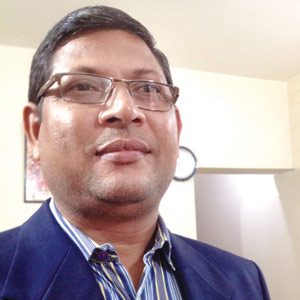
Kishan Pal Singh
Sales Head – South Region,
European Textile Chemical Corporation
In latest trends and developments in wet processing, nowadays, people are more inclined towards less water / low ml, cold process in wet processing which is resulting in time, water & energy saving as well increasing efficiency/productivity.
Indian garments wet processing units are highly lacking of latest machinery. Most of the places we are still seeing that they are doing processing in conventional methods, old top loading/ side door balley machines which are consuming lot of water, time, energy as well less loading/ low productivity. To improve the productivity, productivity/efficiency, saving water, energy and manpower, they have to adopt new and latest machines/ process/methods/ chemicals.
Likewise low temperature/cold desize, enzymes which will save energy and time, apart from that they should use low/ less water front loading machines. We at European Textile Chemical Corporation have all these products. We at Ramsons having all the latest technology machines like front loading machines – in built jet spraywhich is working on ml:r 1;3, 1;4, go green machines attached to front loader -which is working on ml:r 1;1. Latest technological development in wet processing are go green machine, working on ml;r 1;1– manufactured by Ramsons, front loader washing machine with jet spray, working on ml;r 1;3, 1;4 – manufactured by Ramsons and ozone machine for bleaching process which are very much helpful to sustainable process. We at European Textile Chemical Corporation, as a chemical manufacturer developed lot of chemicals keeping in mind sustainability like. Eurozyme 5 in 1 for go green- denim – this is the product which can be used in go green at 1;1 mlr and this is the product in which in single bath and single product we can complete the process of desizing, enzyming/ biopolishing which is in built wetting, lubricating and antiblack staining agent.
Eurozyme 5 in 1/ euro super saver – regular frontloading -for denim – this the product which can be used in regular front loader machine at 1;3, 1;4 mlr and this is the product in which in single bath and single product we can complete the process of desizing, enzyming/ bio polishing which is in built wetting, lubricating and anti-black staining agent. Besides, Eurosoft Soya, Eurosoft Natura- organic softener – which is made with organic oils and gives good handle. We at Ramsons as a garment washing machinery manufacturing strive to do more towards sustainability and keeping in mind all that we developed latest washing machines like.
1) Go green machine – working on ml;r 1;1– manufactured by Ramsons, 2) Jet spray washing machine – working on ml;r 1;3, 1;4 – manufactured by Ramsons 3) Ozone machine – for bleaching process – manufactured by Ramsons – with this machine we can do different level of bleaching without any patchiness and unevenness issue like in conventional bleaching and with very less water. All these are very much helpful to sustainable process
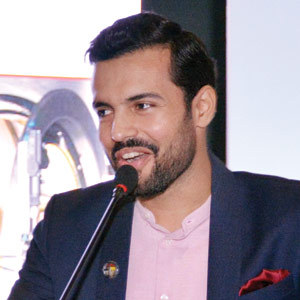
Zehen Arora
Sales Director,
Stefab India Limited
Whether it is a fully established garment manufacturer or even a small garment retail outlet the machines in use should have durable construction, advanced technology with systems which can be maintained and supported economically & efficiently.
The machines should be flexible in terms of performance, capacity, no. of programs to enable a user to process different types of garments and linen. Machines should be built to last and should be backed up by industry’s best manufacturing premises & technology. Solid construction from high quality materials is important if you expect long-term use. Comparing with competitive brands to understand the technological & constructional differences can help to ease out in choosing your right long-term partner. Stefab is the largest company in India to produce apparel processing machines ranging from 15 Kg sampling to 360 kg capacity with tilt feature for easy unloading. The company also produces some accessories like Resin Spray attachments/ containers for the user to make his or her own formula for a customized output.
What should you look for in Garment Processing Machine? Whether it is an apparel processing machine, washer extractor, dryer, dry-cleaning machine or an ironer. The following points are extremely important to choose the right machine:
Ease of operation
The machine you select should have easy, automatic controls that make operation simple and free the operator to handle other tasks. With advance computer display, the operator simply chooses the program as per the type of load, and then pushes a button. Programs on the alpha- numeric display can be named to match items, making selection easy. Because so little judgment is required, new employees get the understanding quickly. Substitute employees can take over with ease, as well.
Operational quality
Washing flexibility should not be sacrificed for operation simplicity. Only a commercial washer-extractor, with professional tumble washing action, can properly clean garments. Three- Beater with a large basket diameter design enhances the tumbling action therefore increasing the level of cleaning, thus providing the lift & drop action necessary to clean hard-to- process items. When comparing machines, compare actual cylinder dimensions along with the door size. A bigger door is always beneficial for easy loading & unloading.
Also, look for microprocessor controls which give a greater range of processing choices as well as more accurate control over how the load is processed. The pre-programmed formulas in automatic machines were developed specifically for the needs of dyeing facilities. They are not standard formulas. The formulas differ in number, type, time & temperature of cycles, as well as chemical supply injection. By pushing a few buttons, these formulas can be adjusted for different types of loads.
Solid construction
Strong construction from top quality materials is important if you expect long-term use. Check competitive brands to see if their construction stands up to industry’s benchmark specifications. Compare specification charts, there can be a big difference in quality. Large, tapered roller bearings and a triple shaft seal to shield the bearings from water. The simplicity and dependability of heavy duty, singlespeed motors. Pre-extract load balancing speed to reduce vibration and extend machine life. Construction with heavy gauge material.
Service is one of the most important factors while you choose your equipment partner. Machines should be simple, durable yet giving the utmost advance features to cater to businesses of all types and sizes. We understand breakdowns and it has always been our first priority to address complaints providing quick service and genuine parts to our customers.
Genuine parts
It is the precision and quality of the spare parts, which make the machines efficient, durable and successful.
Original
Users should always replace a broken/ faulty part with an authentic part. These parts should be the exact same parts that are built into the machines in the factory. There should absolutely be no difference between an original & the spare part. These Spare parts are available locally as well and may cost less initially, but they are not engineered specifically for your machines. Often they need to be replaced and can damage other parts and affect the performance. One has to be careful and it is always best to install authentic parts. Original Parts are easier to install, their performance is better and they last much longer therefore reducing the maintenance costs and downtimes. The above factors can frame out an idea to choose the right equipment for any user based in any part of the world.
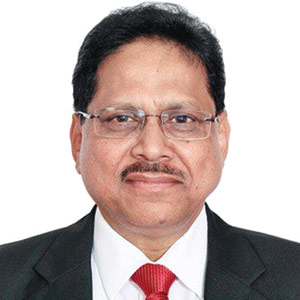
NN Mahapatra
Business Head (Dyes),
Shree Pushkar Chemicals & Fertilisers Ltd.
Different types of effects by the use of Enzymes, Ozone, Laser technology on garments to provide different types of effects and finishes on the garments. It is already practiced in European and American Companies. The more we add value to the garment processing the more price we can get. Different types of functional clothes with functional finishes are being used in the garment wet processing.
Indian garment wet processing industry lacks behind Bangladesh, Sri Lanka, Vietnam and Honduras. More of skill development, machines with high precision are required, joint ventures with developed countries can be a good idea for transfer of latest technology. Our focus is basically on spinning and weaving where we have achieved world class standards but garment wet processing there is miles to go. More technical graduates must join garment dyeing and washing industries. Adequate foreign training is required for the technicians. The Indian Government should come out in the textile budget with different sops for the Indian garment Industries to make it cost effective as compared to Sri Lanka and Bangladesh. Subsidy in Power, Soft Bank Loans, TUF utilization etc. can boost the Indian garment wet processing industries.
For latest garment processing machines still we depend on Italy, Germany and other European countries. Garment printing is done using digital printing (Ink jet printing). The digital inks we have to import from Italy & Germany. It is very costly. Some brands have started dyeing garments using Super Critical Carbon Dioxide (SCO2) medium instead of water as the medium. It is called Super Dry technique. The cost is on a higher cost due to the machinery cost. But it is successful on polyester garments using disperse dyes which can be dyed in SCO2 medium instead of water medium.
We are into manufacturing of reactive dyes for garment dyeing and washing units. We have a range of dischargeable dyes called DYECOL DR dyes which are used in garment dyeing and gives good result in PP spray (Potassium Permanganate). This short process has replaced the lengthy process of dyeing the garments using direct dyes and overdyeing with pigments to get the required fading effect on the garment. DYECOL Black dyes are also giving good effects. It gives good fading effect on the garments. Shree Pushkar Chemicals and Fertilisers Ltd., Mumbai is working on making Tetra Functional reactive dyes which will increase the exhaustion and fixation of reactive dyes on cotton garments. Besides, research is going on by SPCFL R&D how to use reactive dyes on cotton garments using super critical carbon dioxide medium.
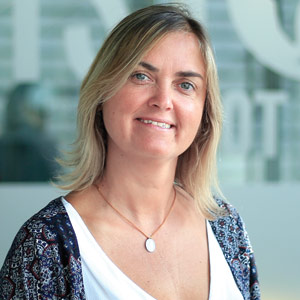
Carmen Silla
Marketing Manager,
Jeanologia
The latest trends in denim garment finishing are looking to the most traditional washing techniques, such as the acid wash and or tie effects. Those trendy finishes brought from the past are showing its best version thanks to the use of the technology that allows us to get the look but not the polluting process. Today, it is possible to produce these latest trends sustainably at an industrial scale, eliminating the most harmful and labour-intensive garment finishing processes.
The latest developments are the Jeanologia 5. Zero finishing, that means Zero manual scrapping & grinding, Zero PP Spray, Zero substance of concern, Zero stones and Zero discharge, Through which it is possible to produce in a sustainable way, without increasing costs or compromising on product quality. By using Jeanologia’s technologies it is possible to reproduce the most emblematic effects of the era (marbling look, bleach stains, etc.) without using the traditional stonewash, saving water and considerably reducing the use of chemicals and energy. As a result, we can achieve authentic looking vintage garments, using technology and in a sustainable manner. We can strengthen the white effect in the “used” area, avoiding the use of potassium permanganate spray.
Furthermore, the washed down effect is achieved without using any chemicals that could be harmful to the environment and workers. As far as potential of Indian garment wet processing industry is concerned, I don’t think it´s a matter of India industry lack, it’s a global situation, textile industry needs a mindset change, to introduce technologies and techniques already available to transform complete the industry to become more efficient, sustainable and ethical. The most revolutionary technology is the Jeanologia patented H2 Zero. H2 Zero is an ecological way to recycle polluted water from washing machines in order to reuse it again in the process. It is designed to reduce water consumption and to offer best productivity and performance with minimum electric consumption, because H2 Zero means ZERØ discharge, no contamination, no complex treatments and no waste of money.
Another technology is the eFlow, a nano-bubbles technology patented by Jeanologia. Based on ultracavitation nano-bubble flow generation, acts as a carrier to transmit chemicals into any garment. Instead of using water as a carrier eflow use the air to transport the chemicals that means up to 90 percent of savings on water and chemicals and a zerodischarge technology. Sustainability has always been Jeanologia’s driving force. Having tackled one challenge at a time, the company is now ready to lead the complete the total detoxification and dehydration of the denim industry, before 2025. We believe, we can contribute to the transformation of the world moving towards a sustainable use of resources and providing solutions to generate a positive impact.
Through Laundry 5.Zero, (The first Jeans finishing plant that guarantees ZERØ® contamination) combination of Jeanologia’s technology: G2 ozone, laser, e-flow, H2 Zero, Smart boxes and the Environmental Impact Measuring (EIM) software, the transformation of current operational model is possible; by moving from selling what is produced to producing what sells. This operational model delivers five fundamental benefits to the textile industry: It is eco-efficient, cost neutral, scalable, agile and digital; connecting design, production and consumer.
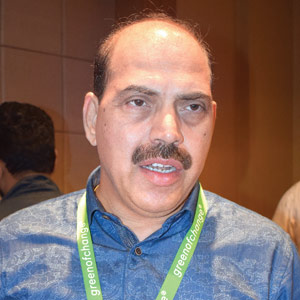
Vijay Jakhmola
Director,
RavChem Specialties Private Limited
While the garment sector in general has been traditionally in the unorganised sector, the wet processing sector has started gaining momentum in recent years unlike initial years of garment manufacturing in the country. However even till date, garment exporters continue to feel this department lowest priority, which can be seen from the fact that the laundry is either managed by masters or on contract basis, unlike other departments.
Presently, denims & dyed garments are trend, and which requires chemicals for processing and primarily major sector does not care much for adopting Zero Discharge of Hazardous Chemicals (ZDHC) Programme which is one of primary concern. However, we all know that our government has understood the concern of sustainability and have already taken an appropriate step to impose to remote level through various strict norms of pollution control and are promoting initiatives for providing technological solutions for providing cleaner and safer environment.
So, for which many responsible companies, have come forward to provide techniques and processes based on automation and data management that allows highest levels of productivity, efficiency, reproducibility and scalability. For dyeing chemicals now gradually, the industry have started shifting their traditional regular dyeing to sustainable dyeing, which assures extremely minimum liquid discharge and also absolutely zero discharge in some cases. Products from GARMON, Italy, (Kemin Industries, USA) have started gaining significant importance as it certifies GREEN SCREEN. Technology for use of washing / finishing machineries, is being rapidly spread, and pioneers of such technology for denim is from a company, Jeanologia, Spain, which manufactures machines for denim finishing including, laser machines, ozone machines, H2 Zero Machines, etc. These machines use very little water in processing denims, they use more air instead of water, and chemical usage is minimum.
Digitalisation is helping to reduce cost of experimenting sampling and production, and new sampling machines, provides the actual visual look before the customer actually puts lots of money and energy in developing a new finish through trial at laundry units. The latest considerations by Signatory Brands, is adoption of Zero Discharge of Hazardous Chemicals (ZDHC) Programme, which is pushing the apparel supply chain to ensure that hazardous chemicals are not discharged without treatment. In India, the normal trend is unless, a rule becomes mandate and penalty is levied for noncompliance of the same, we take it for granted and try to work out alternate measures to evade the same. But now it is high time, when not only government, but complete industry should join hands together for understanding hazardous impact for discharge of untreated chemicals to our environment.
However, government has understood the concern and have pledged for providing cleaner and safer environment. The recent instance which can be quoted is “Launching of SU.RE (Sustainable Resolution) project “in collaboration with CMAI (Clothing Manufacturers Association of India), that focuses on developing sustainable sourcing of raw material, using certified materials, listing approved technologies, communicating the advantages of adopting zero discharge technology, thus aiming for total shifting of primitive technology to new technology that assures no adverse effect on environment. As a chemical supplier, we continuously explore companies who have adapted Green Method of production, and are able to develop chemical products which are free from APEO & NPO content. Companies like GARMON, Italy (KEMIN) certifies all its chemicals as GREEN Chemicals and thus using their products ensures ecofriendly chemicals that we supply in the market. We are also associates of Jeanologia, Spain, who are pioneers of adoption of Sustainable Technology in manufacturing machines for denims & also non denims, while understanding the fashion trend too.
We have also associated with Rochem Separation Systems, which has been providing best-in-class Water Purification Systems who are into technical collaboration with Rochem (Germany), which has over than 2 decades of expertise in researching, developing, manufacturing and installing its Separation Systems powered with the Advanced Membrane Module Technology (AMMT) for processing waste water for recovery and reuse. So, we are following our vision of developing efficient technologies for effluent recycling, desalination and separation processes for industries with difficult-to-handle waste water streams, so, envisaged towards ZLD (Zero Liquid Discharge) programme, for textile/garment wet processing sector. We feel these trend setters, partners for us, for this industry, shall help to provide the most systematic and cost-effective systems to our valued customers based on their needs.


